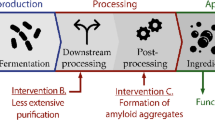Abstract
Ingestion of whey protein rather than casein is associated with a number of enhanced physiological benefits including satiety, glycemic control, and muscle synthesis. Many of these differences can be attributed to apparent differences in digestion and absorption kinetics between these proteins. By simulation of gastric phase digestion, we show that casein coagulates and forms a protein network upon gastric acidification, resulting in an enhanced time viscosity profile, whereas whey proteins stay within solution indicating that altered gastric behavior of these proteins underlies the apparent differences in digestion and absorption kinetics. Moreover, by applying industrially relevant protein modification strategies, the behavior during the gastric phase of these protein sources could be modified. By hydrolysis and Maillard-based modification, protein network formation of casein and concomitantly increased viscosity under simulated gastric conditions could be prevented, likely resulting in faster digestion and absorption kinetics in vivo. On the other hand, cold gelling whey protein aggregates could be prepared that coagulated and formed a temporary protein network under simulated gastric conditions, possibly delaying the overall digestion and absorption kinetics in vivo. Furthermore, combinations of whey proteins or whey protein aggregates and polysaccharides displayed an altered behavior under simulated gastric conditions, most likely as a result of complex coacervation. Overall, the results from this study demonstrate the possibilities within food technology to control the gastric behavior of whey and casein determining the overall digestion and absorption kinetics of these protein sources.





Similar content being viewed by others
References
Alting AC, Weijers M, de Hoog EH, van de Pijpekamp AM, Cohen Stuart MA, Hamer RJ, de Kruif CG, Visschers RW (2004) Acid-induced cold gelation of globular proteins: effects of protein aggregate characteristics and disulfide bonding on rheological properties. J Agric Food Chem 52(3):623–631
Boirie Y, Dangin M, Gachon P, Vasson MP, Maubois JL, Beaufrere B (1997) Slow and fast dietary proteins differently modulate postprandial protein accretion. Proc Natl Acad Sci USA 94(26):14930–14935
Brooks GA (1987) Amino acid and protein metabolism during exercise and recovery. Med Sci Sports Exerc 19(5 Suppl):S150–156
Dangin M, Boirie Y, Garcia-Rodenas C, Gachon P, Fauquant J, Callier P, Ballevre O, Beaufrere B (2001) The digestion rate of protein is an independent regulating factor of postprandial protein retention. Am J Physiol Endocrinol Metab 280(2):E340–348
Darragh AJ, Hodgkinson SM (2000) Quantifying the digestibility of dietary protein. J Nutr 130(7):1850S–1856S
Dupont D, Mandalari G, Mollé D, Jardin J, Rolet-Répécaud O, Duboz G, Léonil J, Mills CE, Mackie AR (2010) Food processing increases casein resistance to simulated infant digestion. Mol Nutr Food Res 54(11):1677–89
Hall WL, Millward DJ, Long SJ, Morgan LM (2003) Casein and whey exert different effects on plasma amino acid profiles, gastrointestinal hormone secretion and appetite. Br J Nutr 89(2):239–248
Hudson HM, Daubert CR, Foegeding EA (2000) Rheological and physical properties of derivitized whey protein isolate powders. J Agric Food Chem 48(8):3112–3119
Kilara A, Panyam D (2003) Peptides from milk proteins and their properties. Crit Rev Food Sci Nutr 43(6):607–633
Koopman R, Crombach N, Gijsen AP, Walrand S, Fauquant J, Kies AK, Lemosquet S, Saris WH, Boirie Y, van Loon LJ (2009) Ingestion of a protein hydrolysate is accompanied by an accelerated in vivo digestion and absorption rate when compared with its intact protein. Am J Clin Nutr 90(1):106–115
Koopman R, van Loon LJ (2009) Aging, exercise, and muscle protein metabolism. J Appl Physiol 106(6):2040–2048
Li CP, Enomoto H, Ohki S, Ohtomo H, Aoki T (2005) Improvement of functional properties of whey protein isolate through glycation and phosphorylation by dry heating. J Dairy Sci 88(12):4137–4145
Lofgren C, Guillotin S, Hermansson AM (2006) Microstructure and kinetic rheological behavior of amidated and nonamidated LM pectin gels. Biomacromolecules 7(1):114–121
Luz Sanz M, Corzo-Martínez M, Rastall RA, Olano A, Moreno FJ (2007) Characterization and in vitro digestibility of bovine beta-lactoglobulin glycated with galactooligosaccharides. J Agric Food Chem 55(19):7916–25
Narici MV, Maffulli N (2010) Sarcopenia: characteristics, mechanisms and functional significance. Br Med Bull 95:139–159
Pennings B, Boirie Y, Senden JM, Gijsen AP, Kuipers H, van Loon LJ (2011) Whey protein stimulates postprandial muscle protein accretion more effectively than do casein and casein hydrolysate in older men. Am J Clin Nutr 93(5):997–1005
Rennie MJ, Bohe J, Smith K, Wackerhage H, Greenhaff P (2006) Branched-chain amino acids as fuels and anabolic signals in human muscle. J Nutr 136(1 Suppl):264S–268S
Schaafsma G (2000) The protein digestibility-corrected amino acid score. J Nutr 130(7):1865S–1867S
Schmitt C, Sanchez C, Desobry-Banon S, Hardy J (1998) Structure and technofunctional properties of protein-polysaccharide complexes: a review. Crit Rev Food Sci Nutr 38(8):689–753
Tessari P, Kiwanuka E, Cristini M, Zaramella M, Enslen M, Zurlo C, Garcia-Rodenas C (2007) Slow versus fast proteins in the stimulation of beta-cell response and the activation of the entero-insular axis in type 2 diabetes. Diabetes Metab Res Rev 23(5):378–385
Veldhorst MA, Nieuwenhuizen AG, Hochstenbach-Waelen A, van Vught AJ, Westerterp KR, Engelen MP, Brummer RJ, Deutz NE, Westerterp-Plantenga MS (2009) Dose-dependent satiating effect of whey relative to casein or soy. Physiol Behav 96(4–5):675–682
Weinbreck F, de Vries R, Schrooyen P, de Kruif CG (2003) Complex coacervation of whey proteins and gum arabic. Biomacromolecules 4(2):293–303
Author information
Authors and Affiliations
Corresponding author
Rights and permissions
About this article
Cite this article
Lambers, T.T., van den Bosch, W.G. & de Jong, S. Fast and Slow Proteins: Modulation of the Gastric Behavior of Whey and Casein In Vitro. Food Dig. 4, 1–6 (2013). https://doi.org/10.1007/s13228-012-0028-7
Received:
Accepted:
Published:
Issue Date:
DOI: https://doi.org/10.1007/s13228-012-0028-7




